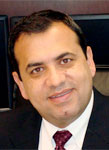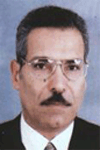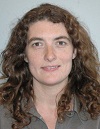Keynote Speakers
Keynote Speaker 1: Prof. Issa Batarseh
Tuesday - Dec 6, 2011: 10:00-11:00
Advanced Solar Energy Conversion Technologies to Enable Smart-Grid Deployment
In recent years, significant research progress has been made in advancing photovoltaic energy conversion technologies. This progress has resulted in more and more countries consider deploying smart-grid technologies. Unfortunately, Jordan ad the MENA region in general have not kept pace with these developments. There is a need in Jordan to move forward with necessary practical and policy decisions to use and deploy such energy saving technologies. Today’s PV installations focus mainly on solar energy conversion, control and grid connectivity technologies. This talk will focus on recent advancement in power electronics inverters for PV energy conversion and how the new solar energy conversion technologies may incorporate smart-grid capabilities in distributed PV systems. Also, why Jordan has great potential to embrace such new technologies.

Issa Batarseh received his B.Sc., M.Sc., and Ph.D. in Electrical and Computer Engineering from the University of Illinois at Chicago in 1983, '85 and '90, respectively. Dr. Batarseh joined the University of Central Florida in 1991. Dr. Batarseh's power electronics research focuses on the development of advanced systems for solar energy conversion to improve cost, power density, efficiency and performance. Dr. Batarseh and his team have published more than 300 journal and conference papers, and he has also published a textbook entitled “Power Electronic Circuits” with John Wiley & Sons. He has supervised 27 Ph.D. Dissertations, 39 MS Theses, and 13 Undergraduate Honor Theses. More than twenty U.S. patents and licenses were granted to commercial products. He is a co-founder for two start-up companies: Advanced Power Electronics Corp. (APECOR) and Petra Solar. Dr. Batarseh is a fellow of IEEE, AAAS, and IEE. Currently, Dr. Batarseh is on professional development leave at Princess Sumaya University for Technology.
Keynote Speaker 2: Prof. Longya Xu
Tuesday - Dec 6, 2011: 2:30-3:30 (was not delivered due to an acceident)
Next Generation Wind Turbine
Based on a New Doubly-Excited Brushless Machine Design and Control
This presentation gives a study of wind turbine system using a new doubly-excited brushless machine. A general survey of state-of-the-art wind turbine technologies is conducted first, highlighting the pros and cons of the existing wind generator systems. Followed is a discussion of the principles and structure of the new doubly-excited brushless machine. Based on the linear model, the torque capabilities and control possibilities are investigated with computer simulation and finite element analysis. The design and control of a prototype doubly-excited brushless machine rated at 250kw are described. Experimental testing results on the prototype doubly-excited brushless machine are presented to verify its flexible operational modes and high energy efficiency over a wide speed-torque range as a next-generation wind turbine generator in renewable energy applications.

Longya Xu received his M.S. and Ph.D. degrees from the University of Wisconsin, Madison, in 1986 and 1990 both in Electrical Engineering. He joined the Department of Electrical Engineering at The Ohio State University in 1990, where he is presently a Professor. He has served as a consultant to many industry companies including Raytheon Co., Boeing, Honeywell, GE Aviation, US Wind Power Co., General Motor, Ford and Unique Mobility Inc. for various industrial concerns. Dr. Xu is the director of the newly established Center of High Performance Power Electronics (CHPPE) at The Ohio State University, supported by The Ohio Third Frontier Program ($6.8M). Dr. Xu received the 1990 First Prize Paper Award in the Industry Drive Committee, IEEE/IAS. In 1991, Dr. Xu won a Research Initiation Award from National Science Foundation for Wind Power Generation. Dr. Xu is also a recipient of 1995, 1999 and 2004 Lumley Research Award for his outstanding research accomplishments from College of Engineering, The Ohio State University. Dr. Xu’s research and teaching interests include dynamics and optimized design of special electrical machines and power converters for variable speed systems, application of advanced control theory and digital signal processor for motion control and distributed power systems in super-high speed operation. In the 20 years, he has conducted many research projects on electrical and hybrid electrical vehicles and variable speed constant frequency wind power generation systems. Dr. Xu is an IEEE Fellow and has served as the chairman of Electric Machine Committee of IEEE/IAS and an Associate Editor of IEEE Transactions on Power Electronics in the past several years. Dr. Xu currently is serving as a member-at-large on IEEE/IAS Executive Board.
Keynote Speaker 3: Prof. Ziyad Salameh
Tuesday - Dec 6, 2011: 2:30-3:30
Vehicle to Electric Grid (V2G) Technology
With sky rocketing oil prices, depleting
oil reserves, environmental pollution, and global warming, the world
as a whole is forced to really consider using electric vehicle as
part of the solution, they serve as distributed moving energy
storage.

Ziyad Salameh got
his Diploma (with honors) from Russia in 1974 and his M.Sc. and
Ph.D. from University of Michigan (Ann Arbor) in 1980 and 1982
respectively. Dr. Salameh is a professor of Electrical and Computer
Engineering (ECE) Department at the University of Massachusetts
Lowell since 1985; he chaired the ECE Department for three years
2001-2004. Prof. Salameh has published more than 120 papers in
renewable energy systems and electric vehicle technologies. Prof.
Salameh is an associate editor of the International Journal of Power
and Energy systems, and the International Journal of Renewable
Energy. Prof. Salameh is the director of the center for Electric Car
and Renewable Energy (EC&RE) that has four research laboratories:
Renewable Energy Lab, Battery Evaluation Lab, Power Electronics Lab,
and Electric Vehicle Lab. The renewable energy lab hosts four wind
turbines 2400w, 1500w, 500w, and 300w. Moreover it has two PV
systems 2500 w and 10.5 kW and 1.2 kW PEM fuel cell, also it has a
super Capacitor evaluation station. Prof. Salameh has been driving
an electric car since 1994; the EC&RE center has 10 electric cars
for research and education. Prof. Salameh is the author of a book
“Renewable Energy Systems Analysis and Design.” He signed a contract
with Elsevier to publish his second book “Electric Vehicle
Technology.”
Keynote Speaker 4: Prof. Mazen Abdel-Salam
Wednesday - Dec 7, 2011: 2:00-3:00
Overview of Transformer Diagnostic Techniques
Power
transformers are critical elements in many industrial, utility and
power generation installations. Should an unexpected failure occur,
it can result in a lengthy downtime, with consequent loss of
operating revenue, and expensive repairs. Planned maintenance is the
best insurance against transformer failure and that’s where advanced
diagnostic techniques come in. They offer an efficient,
cost-effective way of assessing the overall condition of a
transformer so areas of potential concern can be flagged and action
taken well before a potential failure develops into a serious fault.
Furthermore, if an operator has a transformer that is already
causing concern, then diagnostic tests can establish the severity of
the problem, locate the fault and help the service team to provide
expert advice on what action to take. For example, with regular
testing it might be possible for the transformer to continue in
service, while operating under a safe, reduced load, until a planned
service interval is reached.
Transformers are one of the most important
and cost-intensive components of the electrical power supply.
Therefore a big interest for significant diagnostic parameter
exists. These parameters should represent the state of aging of the
insulating components (board and oil) and they should also
show incipient failures which can lead to a damage of the
transformer. A typical failure distribution of high voltage
transformers shows that the highest risks for a failure are the
windings and the bushings of a transformer because in these
regions the highest electrical field occurred during
operation.
This invited keynote speech
is aimed at presenting an overview of power transformer diagnostic
techniques. The traditional diagnostic techniques
include: oil testing, fault detectable by dissolved gas analysis and
interpretation methods of gas data (IEC ratio method, IEEE key gas
method, Doernenburg ratio method, Rogers ratio method, and Duval
triangle method), power factor testing, winding resistance test,
winding ratio test, thermography, oil insulation testing and
monitoring, tap-changer and motor monitoring. The
non-traditional techniques include: in-service partial discharge
(PD) testing, sweep frequency response analysis (SFRA), frequency
domain spectroscopy (FDS), furan testing and degree of
polymerization assessment, polarization and depolarization currents
(PDC) estimation, and recovery voltage measurements (RVM).

Mazen Abdel-Salam
(SM’78-F’93) was born in Egypt. He received the B.Sc. degree in
1967, the M.Sc. degree in 1970, and the Ph.D. in 1973, all in
electrical engineering, from the University of Cairo, Egypt. In
1967, he was with the Academy of Science and Technology, Cairo, as a
Research Assistant. In 1973, he joined the faculty of Electrical
Engineering at Assiut University, Egypt as Assistant Professor. In
October 1977, he became an Associate Professor. During the academic
years of 1977-1979, he was an Alexander-Von-Humboldt Fellow in the
Electrical Engineering Department, Technical University of Munich,
Germany, and the Electrical Engineering Department, University of
Liverpool, England. In September 1979, he began work as a researcher
with General Electric Company, Pittsfield, MA, USA. In January 1982,
he rejoined Assuit University as a Professor of Electrical Power
Engineering. During the academic years of 1982-1984, he was a
Professor in the Department of Electrical Engineering, University of
Jordan, Amman. During the academic years of 1984-1986, he was a
Visiting Full Professor in the Department of Electrical Engineering,
Michigan Technological University, Houghton, MI, USA. From
1990-1994, he was a Professor of Electric Power Engineering in the
Department of Electrical Engineering at King Fahd University of
Petroleum & Minerals, Dhahran, Saudi Arabia. From 2006-2007, he was
a Visiting Full Professor at Toyohashi University of Technology,
Toyohashi, Japan. He had obtained research fellowships at the
Military Technical University of Hamburg, Germany in 1984, at the
University of Leeds, UK in 1988, at Kaiserslautem University,
Germany in 1989, at Michigan Technological University, USA in 1990,
at Toyahashi University of Technology, Toyohashi, Japan in 1995, at
the Technical University of Hamburg, Harburg, Germany in 1996, at
Toyohashi University of Technology, Toyohashi, Japan in 1999, at the
Technical University of Hamburg, Harburg, Germany in 2000, and at
the University of Manchester, Manchester, UK in 2000, 2004 and 2005.
He is currently a Professor of Electric Power Engineering, Assiut
University, Assiut, Egypt. His research activities include corona
studies, digital calculation of electric and magnetic fields,
investigations of high-voltage phenomena, low-voltage distribution
networks, control of electric machines, renewable energy, and
distributed generation . He has published over 290 technical papers
in well recognized journals and in the proceeding of international
conferences. He has supervised 20 M.Sc. and 10 Ph.D. awarded
degrees. He is an author of High Voltage Engineering-Theory and
Practice (New York: Marcel Dekker, 2000). Professor Abdel-Salam was
the Founder/Organizer of the Middle East Power System Conference
(MEPCON) that was held in Egypt, January 1989. MEPCON was held later
1992, 1994, 1996, 1998, 2000, 2002, 2004, 2006, 2008, 2009, and
2010. He has served as a consultant for several engineering projects
in Egypt, Emirates, and Saudi Arabia. He served a member of the
Electrostatic Processes Committee of the IEEE Industrial
Applications Society. He received the Egyptian National Prizes in
1987 and 1992, the National Excellence Prize in Electrical Power
Engineering in 1997, the Japanese Government Research Award for
Foreign Specialists in 1999, Assiut University for Scientific
Excellence in 1999 and 2005, National Prize in Scientific
Distinction in 2000, National Prize in Scientific Creativity in
2001, and National Appreciation Prize in Engineering Sciences in
2004. He is a fellow of the Institute of Electrical and Electronic
Engineers, New York, USA, a fellow of the Institution of Electrical
Technology (IET), London, UK, a fellow of Alexander-Von-Humboldt
(AvH), Foundation, Bonn, Germany, a fellow of Institute of Physics
(IOP), Bristol, UK, and a fellow of Japanese Society for Promotion
of Science (JSPS).
Keynote Speaker 5: Prof. Chris Guy
Thursday - Dec 8, 2011: 8:30-9:30
The Future of the Internet
This talk will cover where the internet and the world-wide-web go from here. It will outline how the internet currently operates (on a best-effort basis) and move on to the need to offer QoS and how that can be done. The talk will include the effects of differential tarrifing for higher quality services and the effect this might have on the so-called digital divide. The explosion of the mobile Internet and the advent of the so-called semantic web will be explored.

Chris Guy is Professor of Electronic Engineering
in the School of Systems Engineering at the University of Reading
UK. After graduating with first class Honours in Engineering Science
from the University of Durham, UK, he worked in industry for 3 years
before returning to academic life. He was a lecturer at University
College London for 9 years, before moving to the University of
Reading in 1989. His research field started out as fault tolerant
computing but gradually moved into networking in general and
specifically, Quality of Service in wireless networks. He is the
author of 2 books, 8 chapters in edited books and about 60 research
papers. He has presented training courses to industry, on topics
related to computer networking, in the UK, in Europe and in
Singapore. He is a member of the IEEE balloting pool for 802
standards. He is an experienced public speaker.
Keynote Speaker 6: Prof. Ana Perez-Neira
Thursday - Dec 8, 2011: 9:30-10:30
Spatial Spectrum Sharing in Wireless Communications
When is Spectrum Sharing needed? Under which
conditions multiple independent transmissions can share the same
frequency band? Which are the Physical Layer Technologies that allow
sharing the spectrum?

Ana I. Pérez-Neira (IEEE S’92, M’95, SM'02) is full professor at UPC (Technical University of Catalonia) in the Signal Theory and Communication department. Her research field is signal processing applied to wireless communications (both mobile and satellite). She has been the leader of 18 projects (7 international and 11 national). She is author of 25 journal papers (SCI indexed) and more than 150 conference papers (18 invited). She is co-author of 4 books and 3 patents. She has been in the board of directors of ETSETB (Telecom Barcelona) from 2000-03 and currently she is in the board of directors of CTTC (Centre Tecnologic de Telecomnicacions de Catalonia). She is member of Eurasip Adcom (European Signal Processing Association) and of IEEE SPTM (Signal Processing Theory and Methods). She has been visiting professor at KTH (Royal Institute Stockholm) during 6 months and at Shandong University (China) during 1 month. She is editor of JASP (Journal of Advances in Signal Processing of Hindawi) and reviewer of various journals and organizations. She has chaired 2 international conferences, IWCLD09 and EUSIPCO 2011, and participated in the organization of other 2 (ESA conference’96, SAM’04). Currently she is Vicerector for research at UPC.
Panel Discussions
Panel Discussion 1:
Renewable Energy Policies and Regulations in
Jordan
Wed - Dec 7, 2011: 10:30-12:30
Moderator: Hisham
Othman, VP Prof. Services, Petra Solar
Panelists:-
·
Ahmad Hiasat, Chairman, Energy Regulatory Commission
·
Ghaled Maabra, Managing Director, National Electric Power
Company
·
Ghaleb Summak, CEO, Kingdom Electricity Company
·
Shukri Halabi, CEO, Millennium Energy
·
Hanna Zaghloul, CEO, Kawar Energy
Panel Discussion 2: The Potential of Electronic Industry in Jordan: Reality or Myth
Thu - Dec 8, 2011: 10:45-12:30
Moderator: Loay Khalaf, the University of Jordan
Panelists:-
·
Zaid Ayoub, JTronix, IrisGuard
·
Basem Khateeb, KADDB
·
Firas Madi, Controcom/BCI
Accepted Papers
Out of 182 submitted papers, 82 are accepted for presentation in AEECT 2011 (PDF preliminary list). Four more abstracts were accepted on the Industrial track out of 8 submitted abstracts.
Kindly contact the conference organizers if you didn't receive a formal notification email message.
The papers that are published on IEEE Xplore Digital Library are in this pdf file.
Agenda
The Final Conference Program is now available in a PDF Program Booklet. This booklet includes the detailed program, maps, and venue information.
The program outline is as in the following table (PDF Version).
|
Day 1:
Tuesday - December 6, 2011 |
||||
|
Time |
A: Large
Aud. |
B: Medium
Aud. |
C: Small
Aud. |
|
|
08:00-05:00 |
Registration |
|||
|
09:00-09:30 |
Opening
Ceremony |
|||
|
09:30-10:00 |
Coffee
Break |
|||
|
10:00-11:00 |
Keynote Speech 1:
Porf. Issa Batarseh, PSUT Solar Energy Conversion
Technologies to Enable Smart-Grid Deployment |
|||
|
11:00-01:00 |
Communications & Networking 1 |
Electrical
Power 1 |
IT
Applications & Services 1 |
|
|
01:00-02:30 |
Lunch in
The University of Jordan Restaurant |
|||
|
02:30-03:30 |
Keynote Speech 3:
Prof. Ziyad Salameh, University of
Massachusetts Lowell Vehicle to Electric Grid
(V2G) Technology |
|||
|
03:30-04:00 |
Coffee
Break |
|||
|
04:00-06:00 |
Communications & Networking 2 |
Electrical
Power 2 |
Intelligent
Systems 1 |
|
|
Day 2:
Wednesday - December 7, 2011 |
||||
|
08:00-05:00 |
Registration |
|||
|
09:00-10:00 |
KADDB Development of UGVs and UAVs
for Military and Law Enforcement Operations |
|||
|
10:00-10:30 |
Coffee
Break |
|||
|
10:30-12:30 |
Panel Discussion 1: Renewable Energy Policies and
regulations in Jordan |
Computers & Electronics |
IT
Applications & Services 2 |
|
|
12:30-02:00 |
Lunch in
The University of Jordan Restaurant |
|||
|
02:00-03:00 |
Keynote Speech 4: Prof. Mazen Abdel-Salam, Assiut Overview of Transformer Diagnostic Techniques |
|||
|
03:00-03:30 |
Coffee
Break |
|||
|
03:30-05:30 |
Communications & Networking 3 |
Electrical
Power 3 |
Intelligent
Systems 2 |
|
|
07:30-09:30 |
Gala Dinner |
|||
|
Day 3:
Thursday - December 8, 2011 |
||||
|
08:00-12:30 |
Registration |
|||
|
08:30-9:30 |
Keynote Speech 5:
Prof. Chris Guy, the University of Reading The Future of the Internet |
|||
|
09:30-10:30 |
Keynote Speech 6:
Prof. Ana Perez-Neira, Technical University of
Catalonia Spatial Spectrum Sharing in
Wireless Communications |
|||
|
10:30-10:45 |
Coffee
Break |
|||
|
10:45-12:30 |
Panel Discussion 2: The Potential of Electronic
Industry in Jordan: Reality or Myth |
Control Systems/Electrical Power |
Internet
Science/Security |
|
|
12:30-08:00 |
Trip to the
Dead Sea (Lunch & Swim in the Movenpick) |
|||
Social Events
Gala Dinner in Amman Marriot. A bus will pick up and return the conference participants staying in the 4 participating hotels. The timetable will be posted soon
Trip to the Dead Sea (Lunch Swim in the Movenpick). The buses leaving to the Dead Sea are going to leave directly from the University of Jordan to the Dead Sea just after the last parallel session.
The Dead Sea Mövenpic has a beach on the
Dead Sea and has several swimming pools; two of them are heated in
December (Infinity Pool and the Winter Pool). If weather permits,
you can swim in the Dead Sea or in the swimming pools.
Optional tours to Petra and Wadi Rum. Details are available on the Travel Page.

